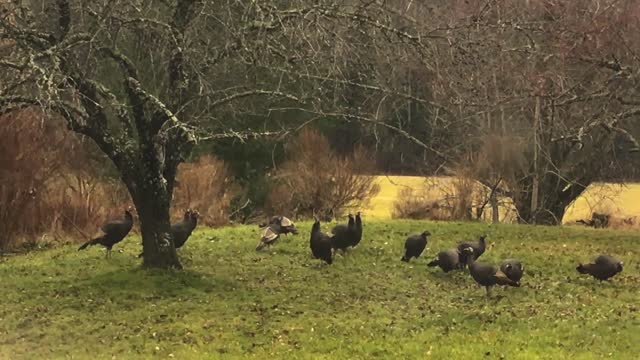Premium Only Content

Turkeys fighting over food and flying into tree
These wild New Hampshire turkeys are regular visitors to my property here in Colebrook. They often get along but when food becomes scarce they tend to bicker back and forth a little.
Eastern wild turkey (Meleagris gallopavo)
Toms (adult males) weigh 18-24 pounds or more; hens (females) about 10 pounds. Plumage is iridescent bronze; dark in males and tips rusty or light brown in females. Wings and fan-shaped tail show alternating dark bands. Neck and head of adult males is reddish, while females have bluish heads with more feathers.
A dewlap (fleshy growth hanging under chin), caruncles (growths located on the side and front of neck), and a snood (a fleshy projection rising above the bill) adorn males. A beard (like bristles on a broom) hangs down from the chest; typical in males and in 5% of females. Males have spurs 1/4 to 1-1/4 inch long on the lower legs.
Range and Distribution
A non-migratory native of much of North America from s. Canada to c. Mexico. Wild turkeys totally disappeared from New Hampshire 150 years ago because of habitat loss and the lack of a fish and game department to regulate hunting seasons. NH Fish and Game began transplanting wild turkeys into the state in in 1969-70 (this initial effort failed), then again in 1975. Today the population is estimated at upwards of 25,000 birds. Turkeys are present in every county in New Hampshire, though severe winter weather and lack of suitable habitat limit the distribution of wild turkeys in the northernmost part of the state.
Turkey Habits and Habitat
Turkeys forage on the ground in flocks, occasionally mounting shrubs and small trees. Acorns, beechnuts, cherries, and ash seeds are primary food sources. Seeds, berries, grasses, sedges and insects are important summer foods. Turkeys eat corn, rye, oats, alfalfa, soybeans, millet, and buckwheat. Grit is important. Adults eat 90% plant matter and 10% insects. Poults eat mainly insects. In winter turkeys visit seeps; they feed on sensitive fern fertile stalks, waste corn, and persistent fruits such as barberry, rose hips, and dried apples.
Adult males gobble to attract females and to repel competing males. Both adults make a variety of noises - yelps, clucks, cackles, purrs, rattles, and gobbles. Wild Turkeys are polygamous. Toms gather a harem of hens by gobbling, strutting, and using dramatic plumage displays. Mating occurs in April and nesting in May. The nest is typically a small depression lined with dead leaves. Nests are located in areas with a well-developed understory or in cut-over areas with slash.
Hens breed in their first year while adult males ("toms") out-compete one-year old males ("jakes"). Hens lay 8-15 eggs. Chicks hatch in 28 days, typically in early June.
Coyote, fox, and fisher are the major predators of adult turkeys. Hens will often abandon a nest if disturbed during incubation. In late summer, hens and their broods often band together to form large flocks. Wild turkeys take advantage of different habitats throughout the year based on their food and nesting needs. In the fall, turkeys forage in mast-producing stands of oak/hickory, oak/pine, and northern hardwoods. Hardwood stands with south-facing slopes and seep areas are favored in winter. Large softwood or hardwood trees are needed for roosting. Wild turkeys forage at farms in winter.
Openings, including pastures, hayfields, burned areas, clear-cuts, blueberry barrens, and natural savannas, are a key component of their habitat. These areas support low herbaceous or grassy ground cover and insects needed for brood-rearing.
Wild turkeys aren't territorial. They travel over 4 to 5 square miles during the year, although during the winter and nesting season they often restrict their movements within 100-200 acres. Turkeys are active during the day, roosting in trees from sundown until sunrise.
-
 LIVE
LIVE
The Dilley Show
1 hour agoTrump Conquering Western Hemisphere? w/Author Brenden Dilley 12/23/2024
3,651 watching -
 DVR
DVR
Geeks + Gamers
2 hours agoSonic 3 DESTROYS Mufasa And Disney, Naughty Dog Actress SLAMS Gamers Over Intergalactic
5.65K1 -
 51:59
51:59
The Dan Bongino Show
3 hours agoDemocrat Donor Admits The Scary Truth (Ep. 2393) - 12/23/2024
399K722 -
 2:32:15
2:32:15
Matt Kohrs
14 hours agoRumble CEO Chris Pavlovski Talks $775M Tether Partnership || The MK Show
74.9K17 -
 28:23
28:23
Dave Portnoy
14 hours agoDavey Day Trader Presented by Kraken - December 23, 2024
90.4K31 -
 59:29
59:29
BonginoReport
5 hours agoTrump, Murder Plots, and the Christmas Miracle: Evita + Jack Posobiec (Ep.110) - 12/23/2024
87.5K66 -
 2:59:14
2:59:14
Wendy Bell Radio
7 hours agoNothing To See Here
82.9K43 -
 2:12:18
2:12:18
TheDozenPodcast
23 hours agoIslam vs Christianity: Bob of Speakers' Corner
66.2K16 -
 14:36
14:36
The StoneZONE with Roger Stone
1 day agoRoger Stone Delivers Riveting Speech at Turning Point’s AMFEST 2024 | FULL SPEECH
94.4K25 -
 18:59
18:59
Fit'n Fire
13 hours ago $6.41 earnedZenith ZF5 The Best MP5 Clone available
50.8K2